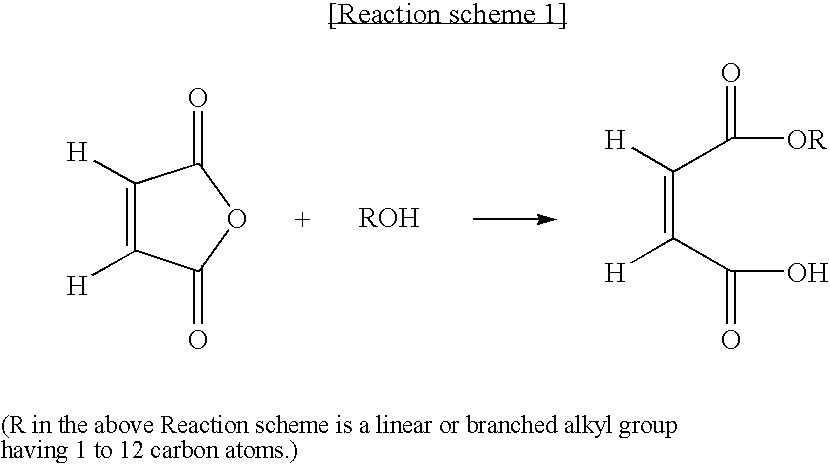Manufacturing Method of Polyaspartic Acid Using Maleic Anhydride
a technology of maleic anhydride and polyaspartic acid, which is applied in the field of manufacturing methods of polyaspartic acid, can solve the problems of low heat transfer efficiency of the process, difficult handling, and inability to manufacture,
- Summary
- Abstract
- Description
- Claims
- Application Information
AI Technical Summary
Benefits of technology
Problems solved by technology
Method used
Image
Examples
example 2
[0034]98 g (1 mol) of maleic anhydride and 69 g (1.5 mol) of ethanol were introduced to a 4-neck flask equipped with a thermometer, a stirrer, a decantor, a condensor and a device for injecting inert gas to prepare monoethyl maleate. 1.1 equivalents (1.1 mol) of an aqueous solution of ammonia were then added to the mixture to give ammonium salts. Subsequently, to the resulting mixture 150 g of n-methylpyrrolidone was added, and then condensation polymerization was effected in oil bath at 170° C. for 6 hrs. As a result, ethanol and water generated in accordance with the reaction were removed and the reaction mixture was converted to polymeric polysuccinimide. The reaction mixture was cooled down to 50° C. and 25% aqueous solution of caustic soda was added to neutralize the mixture. When pH of the solution became 10.0, addition of caustic soda was stopped and the neutralization process was completed. The amount of the 25% aqueous solution of caustic soda consumed for the neutralizatio...
example 3
[0035]98 g (1 mol) of maleic anhydride and 90 g (1.5 mol) of propanol were introduced to a 4-neck flask equipped with a thermometer, a stirrer, a decantor, a condensor and a device for injecting inert gas to prepare monopropyl maleate. 1.1 equivalents (1.1 mol) of an aqueous solution of ammonia were then added to the mixture to give ammonium salts. Subsequently, to the resulting mixture 150 g of n-methylpyrrolidone was added, and then condensation polymerization was effected in oil bath at 170° C. for 6 hrs. As a result, ethanol and water generated in accordance with the reaction were removed and the reaction mixture was converted to polymeric polysuccinimide. The reaction mixture was cooled down to 50° C. and 25% aqueous solution of caustic soda was added to neutralize the mixture. When pH of the solution became 10.0, addition of caustic soda was stopped and the neutralization process was completed. The amount of the 25% aqueous solution of caustic soda consumed for the neutralizat...
example 4
[0037]98 g (1 mol) of maleic anhydride and 90 g (1.2 mol) of butanol were introduced to a 4-neck flask equipped with a thermometer, a stirrer, a decantor, a condensor and a device for injecting inert gas to prepare monobutyl maleate. 1.1 equivalents (1.1 mol) of an aqueous solution of ammonia were then added to the mixture to give ammonium salts. Subsequently, to the resulting mixture 150 g of n-methylpyrrolidone was added, and then condensation polymerization was effected in oil bath at 170° C. for 6 hrs. As a result, ethanol and water generated in accordance with the reaction were removed and the reaction mixture was converted to polymeric polysuccinimide. The reaction mixture was cooled down to 50° C. and 25% aqueous solution of caustic soda was added to neutralize the mixture. When pH of the solution became 10.0, addition of caustic soda was stopped and the neutralization process was completed. The amount of the 25% aqueous solution of caustic soda consumed for the neutralizatio...
PUM
| Property | Measurement | Unit |
|---|---|---|
| temperature | aaaaa | aaaaa |
| temperature | aaaaa | aaaaa |
| temperature | aaaaa | aaaaa |
Abstract
Description
Claims
Application Information
 Login to View More
Login to View More - R&D
- Intellectual Property
- Life Sciences
- Materials
- Tech Scout
- Unparalleled Data Quality
- Higher Quality Content
- 60% Fewer Hallucinations
Browse by: Latest US Patents, China's latest patents, Technical Efficacy Thesaurus, Application Domain, Technology Topic, Popular Technical Reports.
© 2025 PatSnap. All rights reserved.Legal|Privacy policy|Modern Slavery Act Transparency Statement|Sitemap|About US| Contact US: help@patsnap.com

